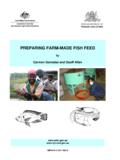Transcription of Lao People’s Democratic Republic - Food and Agriculture ...
1 Report Plant Breeding and related Biotechnology Capacity Lao people s Democratic Republic Funded through the FAO Netherlands Partnership Programme (FNPP) With the support of GIPB Global Partnership Initiative for Plant Breeding Capacity Building and Global Crop Diversity Trust Prepared by Bounhom Thepphavong Sipaseuth Vientiane, September 2007 Table of Contents 1. 1 ENVIRONMENTAL CONDITIONS FOR 1 ECONOMY BASED ON AGRICULTURAL 2 GERMPLASM COLLECTION AND 3 2. DESCRIPTION AND INTERPRETATION OF THE DATA FROM EACH 5 PHONNGAM RICE EXPERIMENT STATION (PRES).
2 5 THASANO RESEARCH AND SEED MULTIPLICATION STATION (TRSS).. 5 Agriculture RESEARCH CENTRE (ARC).. 6 HADDOKEO HORTICULTURE RESEARCH CENTRE (HHRC).. 6 LIVESTOCK RESEARCH CENTRE (LRC).. 6 3. ASSESSMENT OF THE NATIONAL PLANT BREEDING AND ASSOCIATED BIOTECHNOLOGY 7 GENERAL INFORMATION ON NATIONAL CAPACITY TO USE PLANT GENETIC 7 RICE BREEDING 7 Crossing and 8 Linking Rice Breeding and Biotechnology in Lao 9 MAIZE BREEDING 9 SOYBEAN BREEDING 10 CASSAVA BREEDING 10 SWEET POTATO BREEDING 11 VEGETABLES BREEDING 11 OTHER CROP BREEDING 11 BIOTECHNOLOGY 12 4.
3 CONCLUSIONS AND 12 5. STRATEGIES TO STRENGTHEN PLANT BREEDING CAPACITY IN LAO 13 6. 17 Acronyms ACIAR Australian Centre for International Agricultural Research ARC Agricultural Research Center DED German Development Service DNA Deoxyribonucleic Acid HHRC Haddokeo Horticulture Research Center FAO Food and Agriculture Organization of the United Nations FTE Full Time Equivalent FNPP FAO-Netherlands Partnership Programme GDP Gross Domestic Product IRRI International Rice Research Institute PCR Polymerase Chain Reaction PGRFA Plant genetic resources for food and Agriculture PNG Phonngam Rice
4 Variety PRES Phonngam Rice Experiment Station LRC Livestock Research Center Lao PDR The Lao people s Democratic Republic NAFRI National Agriculture and Forestry Research Institute NEM New Economic Mechanism NRRP National Rice Research Program MAF Ministry of Agriculture and Forestry MSG Monosodium glutamate RIL Recombinant inbred lines SDC Swiss Agency for Development and Cooperation SSD Single Seed Descent STEA Sciences Technology and Environment Agency TDK Tadokkham Rice Variety TRSS Thasano Research and Seed Multiplication Station TSN Thasano Rice Variety Global Partnership Initiative for Plant Breeding Capacity Building (GIPB) 1 1.
5 Introduction Lao people s Democratic Republic (Lao PDR) is a landlocked country located in Southeast Asia, bordered by China and Burma to the North, Cambodia to the South, Vietnam to the East, and Thailand to the West. The total land area is 236 800 km2 and nearly 70% of the total land area is occupied by mountains and forests. The total population is 5,800,0000 inhabitants, consisting of three main ethnics: Laosung, Laotheung, and Laoloum. More than 85% of total population is engaged in Agriculture and live in the rural area. Lao PDR has tropical and sub tropical climates distinctly divided into wet and dry seasons.
6 The average annual rainfall is 1 400 mm in the Northern areas and 1 950 mm in the South. It is over 3 000 mm in the Champasack (Boliven plateau) and the Bolikhamsay provinces. Agriculture is one of the most important economic sectors of Lao PDR. Rice is the most important staple food of Laos people and its cultivation practice is done under irrigated and rainfed lowland, and upland conditions. In 2004, 78% of the production came from lowland area planted during the wet season; 14% from the lowland area planted in the dry season and 8% from the upland.
7 The upland system is more important in the Northern part of the country. The largest wet season lowland area is planted in the Central part of the country. Agriculture in Laos has played an important role in helping rehabilitating and stabilizing the national economy. It was achieved through production increase. Lao PDR is one of the countries with a large proportion of land located between 14o and 22o latitude North and 100o and 108o longitude East. It stretches more than 1 700 km from North to South. The topography is largely mountainous, with elevations between 800-1 500 m.
8 The Central and the South regions of the country consist of flat to gently undulating lowland, alluvial plains, at an elevation of 100-300 m. A mountainous border with China and Vietnam bound most of the Northern part of the country. Environmental Conditions for Agriculture The variability in rainfall, temperature, and soil types makes it extremely difficult to farm effectively and to produce optimal and high quality yields. The monsoon season brings severe rains and last from September to October. The wet months vary according to the location from May to September and the rainfall varies with altitude.
9 Annual rainfall distribution varies across the Northern, Central and Southern agricultural regions of Laos. Provinces in the Northern region generally receive less rainfall than the Central and Southern regions with small variations across provinces. Temperatures are as low as 13oC at high altitudes in the coldest period of the wet season and as high as 35oC in the hottest period, between March and May, of the dry season. In the wet-season temperatures are relatively stable and within the range of 20 to 30oC. The crops are grown in different agro-ecosystems ranging from rainfed upland to rainfed lowland.
10 In general, the annual upland cropping consists of rotation systems of food crop such as cassava, maize, soybean and intensive vegetable farming systems, which usually coincide with steep slopes. The land under annual upland systems is very prone to erosion because of minimum soil protection by upland crop. Rice is grown throughout the country under diverse climatic conditions; it is difficult to define the most suitable for its development. Rice is grown under rainfed and irrigated lowland, and rainfed upland conditions throughout the whole country.















